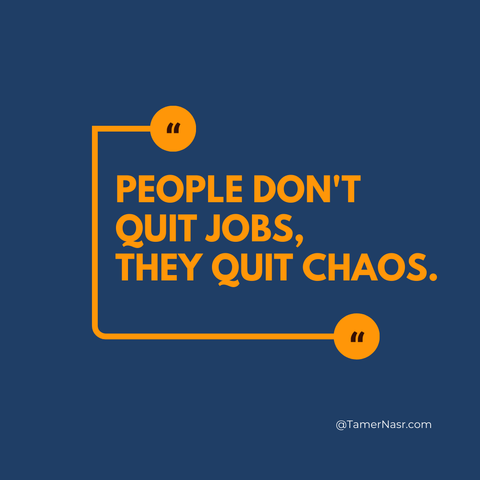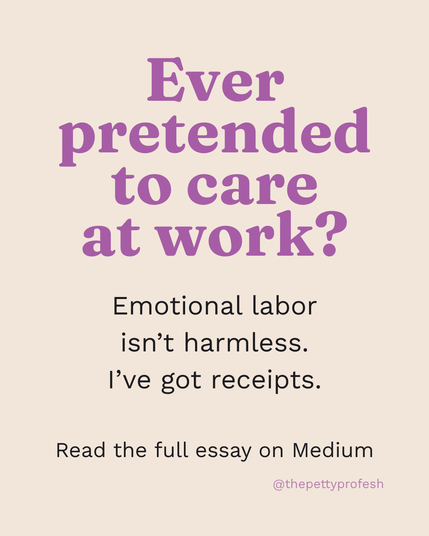I gave up. I don't care about the quality of my output at work anymore - I otherwise would ruin my mental health even more. The codebase is full of ai generated bullshit, which needs heavy refactoring. Nobody cares anymore about knowing what which part of the app does what, reducing complexity or taking responsibility for their own work. Until now I tried write everything by hand and tried to simplify things as I touch it. But now I started #QuietQuitting and as I called it #VibeQuitting.
#quietquitting
Quiet Quitting 2.0 isn’t laziness — it’s balance ✨ Learn how to protect your time, prevent burnout, and master guilt-free productivity. Your life outside of work matters too. #QuietQuitting #WorkLifeBalance #BurnoutPrevention
Companies that fail to adapt risk higher disengagement, lower productivity, and declining morale. The movement underscores a cultural shift toward work-life balance, prioritizing well-being over burnout.
#QuietQuitting #WorkLifeBalance #EmployeeWellbeing #PostPandemicWork #GreatResignation #CorporateCulture (3/3)
. What's your take? #QuietQuitting #WorkplaceCulture #EmployeeRights #WorkLifeBalance #EmployeeWellbeing #FutureOfWork (2/2)
7.10: Ariel & Christina Discuss the Solarpunk Merits of Walkaway by Cory Doctorow
Cory Doctorow’s 2017 novel Walkaway has a reputation in solarpunk circles as a great example of a solarpunk lifestyle, and a must-read book for everyone from the individual who lives and breathes solarpunk to the solarpunk-curious to general science fiction fans. But what is it about Walkaway that gives it solarpunk cred? Ariel and Christina ponder this, discussing features of the novel that could be considered solarpunk, and some that might be more post-cyberpunk than anything, and how some of the ideologies and technologies are or have been applied in our present world. Is the world of Walkaway an achievable solarpunk paradise, or a nice hopeful story featuring very cool gadgets and bites of lefty philosophy? Or something else entirely? What is the draw, here, anyway? Join us to think through some of the quandaries and ideas the book raises.
#episode #solarpunk #SolarpunkPresentsPodcast #podcast #podcasting #Walkaway #CoryDoctorow #SolarpunkFiction #scienceFiction #hopepunk #CatholicWorkers #socialism #communalism #cohabitation #cohousing #philosophy #TangPing #quietQuitting #leftistPolitics #leftistPhilosophy #hotTakesFromYourSolarpunkAunts
Quit Quiet Quitting! The subtle double standards of workplace 'buzzwords'
With 'Quiet Cracking', a new workplace buzzword has entered the discourse. But all these new terms, and especially the reaction to them, reveal some interesting psychology.
Quit Quiet Quitting! The subtle double standards of workplace 'buzzwords'
With 'Quiet Cracking', a new workplace buzzword has entered the discourse. But all these new terms, and especially the reaction to them, reveal some interesting psychology.
Quit Quiet Quitting! The subtle double standards of workplace 'buzzwords'
With 'Quiet Cracking', a new workplace buzzword has entered the discourse. But all these new terms, and especially the reaction to them, reveal some interesting psychology.
Ahhh, gestern gab es auf der Arbeit ne Schulung zu Ordnung und Sicherheit, Meldeprozesse... Teil der Schulung war auch eine Begehung des eigenen Arbeitsplatzes.
Heute bekomme ich n Anschiss, weil ich bei der Begehung einen Sicherheitsmangel gesehen und angesprochen habe...
Quiet Quitting Starts With Poor Projects
People don't disengage from companies—they disengage from chaos. Enhancing your project structure can significantly boost.
#TeamRetention #QuietQuitting #ProjectStructure
I spent 25 years faking it at work—smiling, agreeing, and showing up like everything was fine.
It wasn’t.
This piece is about what changed when I finally stopped performing—and what emotional labor really costs us.
✍️ I Faked It At Work For 25 Years. Now I’m Done.
🔗 https://medium.com/@thepettyprofessional/i-faked-it-at-work-for-25-years-now-im-done-b2753aa3aa34
#EmotionalLabor #WorkCulture #QuietQuitting #MentalHealthAtWork #BurnoutRecovery #ThePettyProfessional
⚠️ Productivity illusion: “Ghostworking” is now standard operating procedure in many offices 🧑💻🕵️♂️
Fast Company reports:
📊 58% of U.S. employees say they regularly pretend to work
📞 15% have faked phone calls
📅 12% schedule fake meetings
🎹 22% use keyboards like musical props
Why?
💼 Fear of layoffs
🤖 Unclear expectations post-AI
🔍 Pressure to “look busy” > deliver impact
Ghostworking isn’t about disengagement — it’s about performing productivity in workplaces where clarity, trust, and job security are eroding.
🔒 Surveillance won’t fix it. In fact, it makes it worse.
🧠 The solution? Leadership that focuses on outcomes, not optics.
🤝 Trust, flexibility, and alignment create real engagement — not performative behavior.
#Ghostworking #FutureOfWork #Leadership #WorkplaceCulture #QuietQuitting #EmployeeEngagement
manu putting the most anti-work people on here to shame
https://www.alojapan.com/1267435/survey-finds-45-of-japans-workers-are-quiet-quitting-in-challenge-to-overwork-culture/ Survey finds 45% of Japan’s workers are ‘quiet quitting’ in challenge to overwork culture #AkariAsahina #AnnualWorkingHours #CareerProgression #GenerationalChange #Japan #JapanNews #JapanTopics #karoshi #Mynavi #MynaviCareerResearchLab #news #QuietQuitting #RecruitWorksInstitute #Survey #tiktok #WorkCulture #WorkLifeBalance #youth A growing share of Japan’s full-time workforce is engaging in “quiet quitting” – doing just enough to get by with…
真心的,我英文係…… 有限公司 😅 不過如果要我估單字 Quiet Quitting 嘅意思,對唔住,我真係估錯咗。 #在職躺平 #英文 #QuietQuitting
Trends wie #QuietQuitting und der Wunsch nach einer #WorkLifeBalance fordern die moderne Arbeitswelt heraus. Worum geht es arbeitenden Menschen? https://www.evangelische-aspekte.de/arbeit-und-sinn/
It is often said that silence implies assent. But in organisations, it often signals something else entirely: fear, disengagement, or quiet resistance.
#Leadership #OrganisationalBehaviour #QuietQuitting #EmployeeVoice #PsychologicalSafety #Management #WorkplaceCulture #SilenceAtWork
https://robert.winter.ink/silence-in-organisational-behaviour/
Silence in Organisational Behaviour
Silence in organisations isn't agreement—it's often fear, disengagement, or quiet resistance. Exploring defensive silence and quiet quitting, the piece argues that leadership must move beyond authority toward real consensus. Listening for what's not being said is essential for trust, effective decisions, and a culture where people truly speak up.Another day, another meeting, and the thrumming monotony was broken by something which is commonplace when there is no consensus—silence. The moment put me in mind of the French composer Claude Debussy (1862–1918) who observed: ‘Music is the silence between the notes.’ Yet in an organisational context, silence is seldom music and never golden. This rule is evident when people are in accord, particularly in a room full of influences, as you will witness the social types tripping over their own tongues in an effort to agree and to be seen to be agreeing.
As an academic at heart, this always strikes me as odd, because if I agree with something a small incline of the head is sufficient to show my support. When I think the argument being presented is, to use a technical term, a load of bollox, then a vociferous rebuttal is in order. As this swirling mass of ideas took me tumbling down a rabbit hole, I was brought sharply back to the present by the meeting convener who said: “well, we are all agreed.” Realising agreement had not been reached, I weighed in and scribbled a hasty note to pen an article about silence in organisations.
Reframing Organisational Silence
Silence in organisational contexts is often misunderstood as apathy or passive agreement. In contrast to principle qui tacet consentire videtur (lit. ‘he who is silent is taken to agree’ or silence is assent), silence in organisational settings is often deeply strategic, emotional, and political. Far from passive, silence may be used defensively to avoid negative repercussions, to disengage from flawed processes, or to express dissent without confrontation.
Organisational silence can be defined as the conscious withholding of opinions, concerns, or feedback about organisational problems or issues. Its two primary forms—defensive and acquiescent silence—signal different but equally troubling employee experiences. Defensive silence stems from fear of negative consequences, whereas acquiescent silence is driven by resignation or futility.
More recently, the popular discourse around ‘quiet quitting’ has brought these issues out into the open. While sometimes mischaracterised as laziness, quiet quitting—doing only what one is paid for and nothing more—reflects a deliberate withdrawal from discretionary effort . It is, in essence, a silent renegotiation of the psychological contract when employees perceive management as inattentive, exploitative, or unresponsive.
This reappraisal of silence as agency challenges common assumptions in management and organisational theory. Voice and silence are not merely opposites but are shaped by different psychological and contextual factors. The suppression of voice is often a rational act of self-protection in the face of perceived power imbalances and cultures of fear.
Critically, silence is not equally distributed across organisational hierarchies. Employees at lower levels or those from marginalised groups often experience higher risks when speaking up and thus may be more likely to engage in silence as a survival strategy. This unequal distribution undermines the legitimacy of decisions based on an apparent lack of objection. The absence of overt dissent should not be mistaken for consensus—it may in fact signal a culture of suppression.
The Organisational Cost of Silence
The presence of widespread silence can corrode an organisation’s culture, distort decision-making, and hinder the capacity to learn and adapt. Elizabeth Wolfe Morrison and Frances Milliken rightly identified silence as a collective phenomenon with systemic consequences: when employees consistently withhold input, organisations become less effective at detecting problems, innovating, or responding to change.
This effect has become more visible in the wake of increased attention to employee engagement. Silence is significantly associated with lower organisational commitment and trust in management. When employees feel that their input is ignored, or worse, punished, they are less likely to invest emotionally or cognitively in their work. Instead, they retreat—physically or psychologically.
Moreover, organisational silence impairs the quality of decision-making. Deliberative, evidence-based management relies on the open exchange of perspectives, data, and experience. When silence prevails, decisions are made with incomplete information, often by managers surrounded by false consensus or sycophancy. This results in a phenomenon sometimes referred to as ‘decision-making under silence’, which heightens the risk of failure due to blind spots, groupthink, or untested assumptions.
Silence can also reflect and reinforce problematic management practices. Authoritarian or overly hierarchical management styles, which rely on positional authority rather than reasoned deliberation, persuasion or consensus-building, are especially vulnerable to silence cultures. In such settings, managers may equate compliance with commitment, failing to realise that initiatives are being quietly resisted or ignored. This is particularly damaging in change management contexts, where alignment and buy-in are essential.
The emergence of ‘strategic silence’ as a form of passive resistance illustrates how employees express disapproval not through active protest but through passive withdrawal. This form of resistance undermines organisational initiatives from within—not through sabotage, but through disengagement and non-participation. When management fails to recognise these signals, silence becomes entrenched.
From Authority to Consensus
To respond effectively to organisational silence, managers must rethink both how they exercise authority and how they understand consensus. Traditional management models, particularly transactional or authoritarian forms, often misread silence as compliance or agreement. This misreading creates a dangerous illusion of consensus—what scholars have called a ‘false positive’ of engagement.
Instead, management must become deliberative, inclusive, and contextually aware. Psychological safety—the belief that one can speak up without fear of retribution—is foundational to any meaningful engagement with silence. Managers must create conditions where dissent is not just tolerated but actively solicited and rewarded.
Building such cultures requires more than open-door policies. It demands systemic efforts to flatten hierarchies of voice. This includes mechanisms such as anonymous feedback channels, regular listening forums, and shared governance models. More importantly, it requires a shift in management identity—from commander to facilitator, from decider to convener.
A promising framework in this regard is ‘voice-enabling management’, which combines role-modelling of voice behaviour, reinforcing norms of candour, and actively coaching team members to express concerns constructively. Voice-enabling managers recognise that silence may be rational, even justified, and that rebuilding trust takes time and consistency.
Moreover, consensus-building must be distinguished from consensus-assuming. True consensus arises through deliberation, inclusion, and mutual understanding—not from the absence of voiced opposition. In environments where silence is common, managers must interrogate not only what is being said, but also what is not.
One practical implication is the need for management training that emphasises interpretive skills—learning to read organisational silences as signals of risk rather than signs of agreement. This includes attention to micro-behaviours in meetings (e.g., who speaks, who stays silent), exit interviews, and discrepancies between formal feedback and informal culture.
Additionally, managers must model vulnerability. When senior figures admit mistakes, invite critique, or acknowledge uncertainty, they signal that silence is not necessary for survival. Such management models foster conversational spaces where dissent is valued as a contribution, not a threat.
Finally, organisations must link voice to impact. Employees are more likely to speak up when they believe their input will lead to action. The voice-to-change relationship is essential: it reinforces the idea that engagement matters, and that silence is not the only rational response.
A Most Vital Competency
Silence in organisational behaviour is not a neutral absence but a powerful form of presence. Whether defensive, strategic, or disengaged, silence signals misalignment between leaders and followers, between organisational vision and lived experience. It represents a breakdown in trust, communication, and legitimacy.
Management must evolve to meet this challenge. Rather than interpret silence as assent, managers must develop the skills and systems to surface dissent, build consensus, and foster genuine engagement. This involves not only encouraging voice but also interrogating why silence persists. In this context, effective management is not about issuing directives—it is about building the conditions for collective understanding.
As organisations become more complex, diverse, and change-driven, the capacity to hear what is not being said may become the most vital management competency of all.
Good night, and good luck.
#ConsensusBuilding #DefensiveSilence #EmployeeVoice #Management #OrganisationalBehaviour #OrganisationalSilence #PsychologicalSafety #QuietQuitting #StrategicLeadership #WorkplaceCulture
Not a new idea, but one we should embrace instead of the dog eat dog world the predatory oligarchs glorify.
Enjoy life on your terms, not theirs.
"So I commended the enjoyment of life, because there is nothing better for a person under the sun than to eat and drink and be merry. For this joy will accompany us in our labors during the days of our lives that the Divine gives us under the sun." - Kohelet / Ecclesiastes 8:15
#SelfCare #AntiCapitalism #Community #Resilience #QuietQuitting



